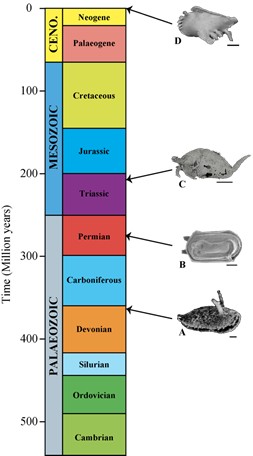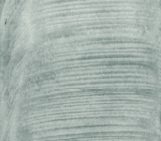
Name of the proxy
Ostracoda
Type of proxy
Paleoenvironment proxy
Paleoenvironment
All types of aquatic environments but here we will focus on marine waters
Period of time investigated
Phanerozoic
How does it work?
Ostracoda are crustacean of millimetre size which have inhabited all types of marine environments from the Ordovician to today (e.g. Salas et al. 2007) and colonized continental water bodies during the Carboniferous (Bennett et al. 2012). They are characterised by their bivalve calcified carapace articulated dorsally which encloses and protects the soft parts and appendages of the animal (Figure 1). The majority of Ostracoda live on or in the sediments: they are consequently highly sensitive to their environment.
What are the key findings that have been done using this type of proxy?
Throughout their history, marine Ostracoda inhabiting deep seas had very different morphologies from the contemporary shallow water species: thin shells, long, hollow and delicate spines and no eye spots (although this point is discussed; Figure 2). Based on the study of sediments, associated organisms and analogies with modern-days Ostracoda, ostracodologists concluded that those animals developed in low energy environments ranging from 500 to 5000 m depth in connection with global ocean cold water supplied by ice-caps (Lethiers & Feist 1991). This discovery provided a unique window into the oceanic circulation through geological times and the existence of a cold deep-water layer. The presence and characteristics of these Ostracoda have been cornerstones in understanding that the thermohaline circulation has not been constant through the Phanerozoic but rather existed only during the Late Ordovician, the Carboniferous-Permian interval and from the Eocene to today (Benson 1975).

Figure 2. Simplified geological time scale with Eras and Periods of the Phanerozoic. On the right are reported some archetypal deep-sea Ostracoda from the literature (for all photos, scale bar is 100 µm). A: Processobairdia spinanterocerata Bless & Michel, 1987; B: Cristanaria katyae Crasquin-Soleau, 2008; C: Gencella taurensis Forel, work in progress; D: Pedicythere klothopetasi Yasuhara et al., 2009.
Today, this field of research is very active as Ostracoda are the only metazoans regularly fossilized in deep-sea sediments over an extremely long period of the history of Earth. Their long fossil record spanning 5 mass extinctions and periods of extreme climatic changes make them precious tools to unravel the response of deep-water ecosystems to past climatic changes and the rhythms of their recovery. The extreme sensitivity and history of these peculiar animals make them sentinels of deep-sea ecosystems facing ongoing global temperature increase and acidification of marine waters.
References
- Bennett, C.E., Siveter, D.J., Davies, S.J., Williams, M., Wilkinson, I.P., Browne, M., Miller, C.G. 2012. Ostracods from freshwater and brackish environments of the Carboniferous of the Midland Valley of Scotland: the early colonisation of terrestrial water bodies. Geological Magazine, 149, 366-396.
- Benson, R.H. 1975. The origin of the psychrosphere as recorded in change of deep sea Ostracode assemblages. Lethaia, 8, 69-83.
- Bless, M.J.M., Michel, M.P. 1967. An ostracode fauna from the Upper Devonian of the Gildar-Monto region (NW Spain). Leidse Geologische Mededelingen, 39, 269-271.
- Crasquin-Soleau, S., Carcione, L., Martini, R., 2008. Permian ostracods from the Lercara Formation (Middle Triassic to Carnian?, Sicily, Italy). Palaeontology, 51, 537-560.
- Lethiers, F., Feist, R. 1991. Ostracodes, stratigraphie et bathymétrie du passage Dévonien–Carbonifère au Viséen Inférieur en Montagne Noire (France). Geobios, 24, 71-104.
- Salas, M.J., Vannier, J., Williams, M. 2007. Early Ordovician Ostracods from Argentina: their bearing on the origin of Binodicope and Palaeocope clades. Journal of Paleontology, 81, 1384-1395.
- Yasuhara, M., Okahashi, H., Cronin, T.M. 2009. Taxonomy of Quaternary Deep-Sea Ostracods from the Western North Atlantic Ocean. Palaeontology, 52, 879-931.
Written by Marie-Béatrice Forel
Edited by Célia Sapart and Caroline Jacques




Pingback: The Last Word On Nothing | Waterpocket, Tinaja, Kissing Pool